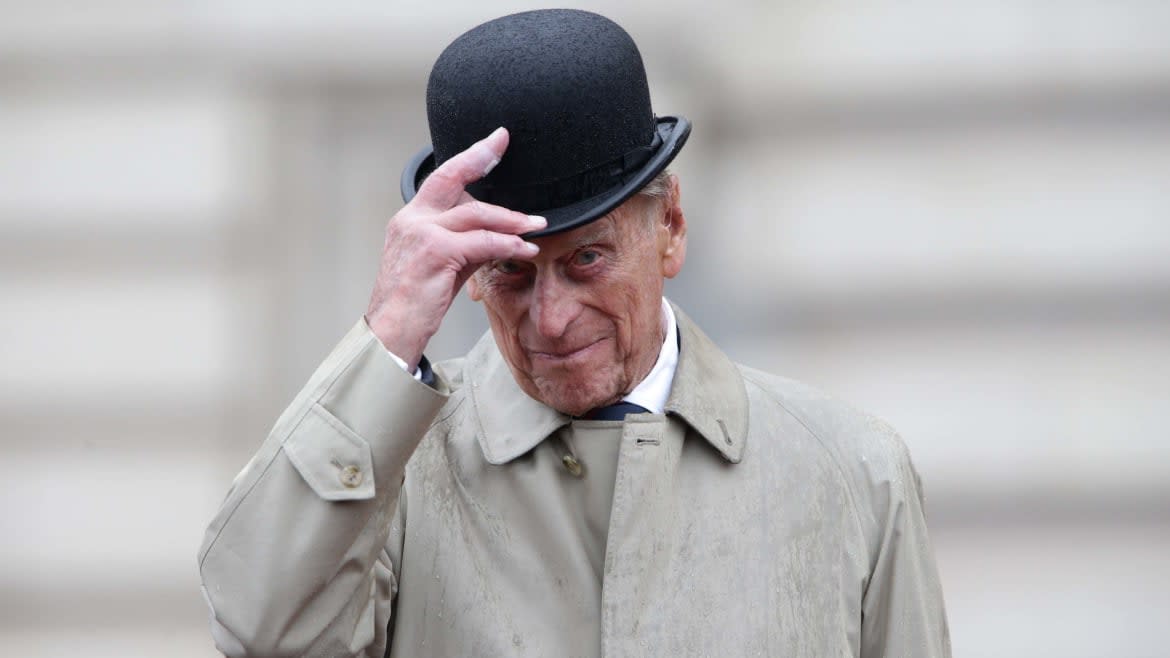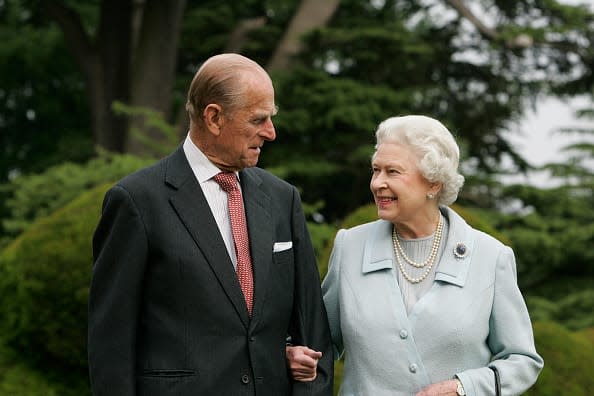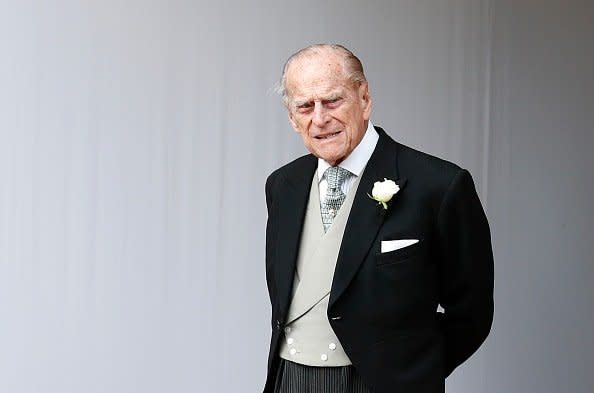Prince Philip, Queen Elizabeth’s Husband and Duke of Edinburgh, Dies at 99

- Oops!Something went wrong.Please try again later.
- Oops!Something went wrong.Please try again later.
Prince Philip, husband and beloved consort of Queen Elizabeth II, died Friday morning at Windsor Castle.
Philip’s death marks a somber endpoint to one of the most extraordinary royal love stories of recent times. The queen will now enter an eight-day period of mourning, with Philip’s funeral expected to take place at St George’s chapel in Windsor Castle.
Philip first met the queen when they were both children, and they married despite fierce opposition from the establishment, which feared his Germanic ancestry would alienate the public. Despite oft-repeated rumors of philandering on his part, theirs was that rare thing: an enduring and truly supportive royal marriage.
If you love The Daily Beast’s royal coverage, then we hope you’ll enjoy The Royalist, a members-only series for Beast Inside. Become a member to get it in your inbox on Sunday.
Their final years together also held one huge surprise. Philip, who retired from active royal duties in August 2017, had planned to see out his retirement largely alone, living quietly at a farmhouse on the Sandringham estate while his wife stayed, for the most part, attending to her duties in London. However when the coronavirus pandemic struck, Philip and Her Majesty moved back in together, forming a bubble and living together at Windsor Castle from Easter 2020 for four months.
Inside the Queen and Prince Philip’s Love of the Simple Life
It was by far the longest period of time the peripatetic duo had ever spent together continuously in each other’s company, and under one roof.
They then traveled together to Scotland for a month, before heading to Wood Farm until October 2020. Philip then returned to Windsor with the queen, and they again locked down there all the way to Christmas and into 2021. In February 2021, Philip was taken to hospital in London from Windsor after feeling unwell. Aides played down the severity of his illness and emphasized that he walked unaided into hospital.
Philip spent 14 days and 13 nights at the private King Edward VII Hospital before being transferred to St. Bartholomew’s Hospital, where doctors treated him for an infection, as well as observing and testing him for a pre-existing heart condition.
He was last seen in public on March 16, while leaving the hospital in London, where he had been recuperating. He spent 28 days in hospital in total. He eventually died Friday morning, “peacefully,” the palace reported.
A military procession in London to honor the duke has been long planned, but public attendance will likely be restricted due to COVID regulations. He is expected to be buried in the grounds of Frogmore House.
It is with deep sorrow that Her Majesty The Queen has announced the death of her beloved husband, His Royal Highness The Prince Philip, Duke of Edinburgh.
His Royal Highness passed away peacefully this morning at Windsor Castle. pic.twitter.com/XOIDQqlFPn— The Royal Family (@RoyalFamily) April 9, 2021
There had been several other health scares, including a heart attack at Christmas 2011, and being twice admitted to the hospital with infections in 2012. Concerns for his health stirred again after he and the queen failed to travel to Sandringham for Christmas 2016. The palace said the pair had “heavy colds.”
Despite his advanced years and health challenges, Philip maintained as full a schedule of events as possible, and continued his beloved sport of carriage driving until the coronavirus made it impractical. He was also a backyard inventor with a fascination for science, as The Crown showed in an episode centered around the moon landing.
Prince Philip, who was due to turn 100 on June 10, was born Prince Philippos Prince of Greece and Denmark on the Greek island of Corfu in 1921. He was mocked at prep school for having no surname, and only ever being known as “Philip of Greece.” He took the last name Mountbatten when he became a naturalized British citizen before marrying Elizabeth.
Philip’s father, Andrew, was the brother of the king of Greece, and his mother, Alice Battenberg (the original Germanic formulation of the name Mountbatten), was a granddaughter of Queen Victoria. Alice was very beautiful but almost completely deaf. She camouflaged her disability by learning to lip-read in multiple languages.
In December 1922, Philip’s parents were compelled to leave Greece in a hurry after his uncle was deposed as king, and Philip, then only 1 year old, was smuggled out of the country in a crib made out of a fruit crate.
Philip’s father subsequently spent most of the rest of his life living a playboy lifestyle in the south of France, but his mother was sent to a mental institution in Germany in 1930. Alice was “diagnosed” with a “neurotic pre-psychotic libidinous condition” and on the recommendation of Sigmund Freud, was subjected to an exposure of the gonads to X-rays, in order to accelerate menopause.
Philip’s parents rarely saw him, and he spent most of his childhood at boarding schools or with his maternal uncle, Louis (“Dickie”) Mountbatten. Philip went to school in England, Germany, and then Gordonstoun in Scotland, where he was head of the school cricket and hockey teams and became head boy.
After his troubled childhood, he said it was one place he really felt at home, and he looked back fondly on his time there, despite the harsh schooling that included cold showers every morning.
Princess Elizabeth and Philip first met when they attended the wedding of Philip’s cousin Princess Marina of Greece to the Duke of Kent, who was an uncle of Princess Elizabeth, in 1934. Things stepped up a gear when he made a visit to Buckingham Palace in 1939. He was 18 and Elizabeth was 13. The future queen’s governess described how, while they were playing with a clockwork railway, Philip came into the room—and everything changed.
“For a while, they knelt side by side playing with the trains. He soon got bored with that,” Princess Elizabeth’s governess said. “We had ginger crackers and lemonade in which he joined and then he said, ‘Let’s go to the tennis courts and have some real fun jumping over the nets!’ At the tennis courts, I thought he showed off a little too much. Lilibet (Elizabeth) said, ‘How good he is! How high he can jump!’ He spent a lot of time teasing plump little Margaret.”
Later that evening, when Philip went for dinner with the king, Elizabeth had already been sent to bed, in accordance with the nursery schedule.
Philip joined the Royal Navy in 1939 and attended Dartmouth College as a cadet.
Philip was not protected by any royal patronage and was active in the Second World War. As a member of the Royal Navy, he was in charge of operating the searchlights on a battleship called the Valiant. In the battle of Cape Matapan, where the British wiped out a large part of the Italian fleet in a night-time attack, Philip was awarded a medal and mentioned in dispatches for his skill with the lights, which contributed to the devastating results.
When asked about the action later by his cousin Alexandra, Philip told her, “It was as near murder as anything could be in wartime. The cruisers just burst into tremendous sheets of flame.” Immediately after the attack, Philip used his searchlights to scour the ocean for survivors to rescue.
In 1947, to pave the way for marriage to Elizabeth, he became a naturalized British subject, and adopted the surname Mountbatten, an Anglicized version of his mother’s name, Battenberg. His German connections were a source of concern to some in the royal family so soon after the Second World War, but attempts to dissuade Elizabeth from marrying him proved futile. He converted from Greek Orthodox to the Anglican religion, and renounced his allegiance to the Greek crown.

The queen and Prince Philip, The Duke of Edinburgh re-visit Broadlands, to mark their Diamond Wedding Anniversary on November 20, 2017. The royals spent their wedding night at Broadlands in Hampshire in November 1947, the former home of Prince Philip's uncle, Earl Mountbatten.
The engagement between Princess Elizabeth and Lt. Philip Mountbatten RN was announced on July 9, 1947, and they were married in Westminster Abbey on Nov. 20, 1947. The day before his wedding, King George VI titled his future son-in-law Philip as the Duke of Edinburgh, Earl of Merioneth, and Baron Greenwich, of Greenwich in the County of London.
In February 1952, Philip and Elizabeth were in Kenya staying at Tree Tops hotel during a tour of the Commonwealth when news came of the death of the princess’ father King George VI. They returned to Britain for the princess to take up her new role as Queen Elizabeth II, and Prince Philip as royal consort.
He resigned from the Royal Navy, and devoted his life to supporting the queen, but was rumored to have had several affairs. A month before Elizabeth was due to give birth, Philip was introduced to Pat Kirkwood, the first of the showgirls with whom he was rumored to have had an affair, and whose legs the theater critic Kenneth Tynan pronounced the “eighth wonder of the world.”
Despite being compelled to walk “two steps behind” his wife, he was reputed to be a sometimes tyrannical head of the family—as well as a deeply devoted husband and consort. Prince Charles complained on camera to the film maker Jonathan Dimbleby about his father’s fierceness.
Philip will also be remembered for his outrageous sexist and racist comments. He told students not to stay in China too long or they would develop “slitty eyes,” he said a badly fitted fusebox looked like it had been installed by an “Indian,” and he told the CEO of a wind farm he must believe in fairytales if he ever thought wind power would work. Just weeks before the jubilee celebration, he commented that he would “be arrested” if he “unzipped” a woman wearing a dress with a zip.
The comments obscured his phenomenal commitment to royal life, and a life of dedicated duty. When he finally stood down from public life in 2017, he was patron, president, or a member of over 780 organizations.
The Telegraph calculated that, over his life, he carried out over 22,000 public engagements, made 637 solo overseas visits and gave 5,493 speeches.
Prince Philip was a subscriber to the magazine Flying Saucer Review, and once sent his equerry, Sir Peter Horsley, “to meet an extraterrestrial humanoid at a house in Ealing,” according to the writer Philip Eade.
His interests included flying, sailing, polo, carriage driving, and shooting.
Philip is survived by his wife, four children, eight grandchildren, and ten great-grandchildren.

Prince Philip, Duke of Edinburgh attends the wedding of Princess Eugenie of York to Jack Brooksbank at St. George's Chapel on October 12, 2018 in Windsor, England.
Get our top stories in your inbox every day. Sign up now!
Daily Beast Membership: Beast Inside goes deeper on the stories that matter to you. Learn more.

